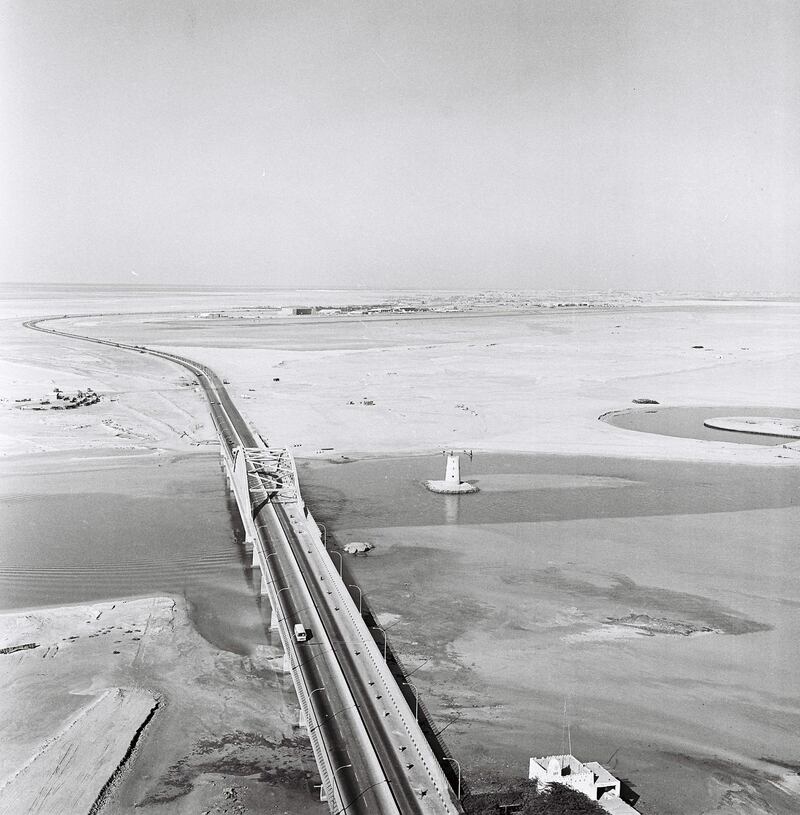It was, as George Bell later recalled, "just another boring Decca day".
Looking to drum up some new business in Dubai, the maritime navigation company decided to send its young Abu Dhabi-based station engineer away for a few days on a sales pitch.
The first part of the journey passed without incident. It was on his return to Abu Dhabi that Bell discovered his mission could have fatal consequences.
It was the early 1960s, and Bell had been allocated the company Land Rover, the first time the vehicle had made such a long journey. Heading back to Abu Dhabi a little later than planned, he realised the setting sun was making it harder to see the tracks in the sand that were the only clue that a driver was following the right path. It was then that his troubles began.
The Land Rover’s engine was running hotter than normal, forcing Bell to top up the radiator with his precious drinking water. Next, he began to run out of petrol.
Retrieving the five litre jerry can, Bell realised he had another problem.
“I knew it was empty,” he wrote. “There was a smell of petrol in the open back of the Land Rover, but that was all. [The can] had been rubbing against a sharp corner where I had fixed it. I could see it now. All of it had gone.”
Unsure of his location, with barely enough fuel for another 20 kilometres and a fast-dwindling supply of water, Bell was faced with the very real prospect of death in the desert.
_________________
Read more:
Abu Dhabi institution El Dorado to close its doors after 47 years
Stranger landscape: the architectural secrets of the E11, the UAE’s longest road
How a road in the UAE paved the way for politicking and national identity
_________________
In his desperation, he debated setting fire to the vehicle as a signal for help. “It was brand new and cost a lot more than I expected to earn. Never mind the cost. This was my life we were talking about.”
The arrival of a pickup truck saved his life – and the Decca Navigation Company’s expensive Land Rover. Bell was able to barter for enough fuel and water to get home and followed the driver back to the safety of the Maqta Crossing.
Returning to base, colleagues asked about the trip. Discretion, he decided, was the better part of valour. “I did not mention anything to anyone. After all, it was just another boring Decca Day.”
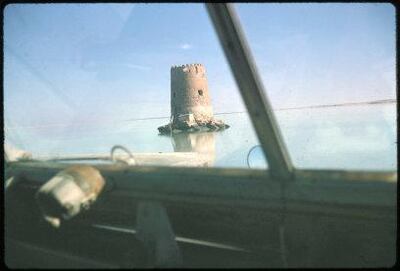
Cars may have been more plentiful on the route from Abu Dhabi to Dubai by the 1960s, but the passage had been essentially unchanged for hundreds of years. The route was nothing more than a sand track that hugged the coast for nearly 160 kilometres.
In wet weather there was constant danger of becoming bogged down in the sabqa, a treacherous mixture of gypsum and sand that would swallow a vehicle up to the axle. Bandits were another occasion hazard, even into the 20th century.
Many travellers preferred to make the journey by dhow, a journey that would take a day and a night, even in calm seas, but at least had a more certain prospect of arrival.
The discovery of oil in the late 1950s brought new prosperity and ushered in the age of the motor car – even if this was not accompanied by roads.
Journeys between the two Emirates were a major event. Susan Hillyard, the wife of the BP representative in Abu Dhabi from 1956 to 1958, set out with her husband, Tim, for a party in Dubai, the excuse being Queen Elizabeth II’s birthday in April.
Hillyard had only seen the route from the Abu Dhabi side of the Maqta crossing, a crude stone causeway built in the early 1950s, that meant travellers did not at least have to wait for the receding tide to keep their feet dry.
"It seemed to stretch to the horizon with just a few tracks on it," she later recalled in her memoir Before the Oil. "At that point I could not see the piles of bleached camel bones."
The Hillyards also followed an accepted practice for the journey in those days, sending a message to Dubai with the exact time of their departure. If anything went wrong, the delay in the arrival would be soon noted.
During the three-hour drive, the Hillyards saw no sign of life beyond a large monitor lizard and ominously circling birds of prey. About 45 minutes from Dubai, they noticed what seemed to be a black boulder by the side of the road.
It turned out to be an elderly Arab man, cloaked against the heat and the blowing sand. He had been waiting all day in the hope of a lift, and after climbing on board, took just a few sips of the offered water bottle.
“He had sat there since dawn without seeing another vehicle,” Hillyard wrote. “The same could happen to us. Even though we were in sight of Dubai, it would be a long dehydrating walk in that heat.”
Those first journeys involved the crossing of an international border, since Dubai and Abu Dhabi were separate countries, with customs posts at each end of the route. In the early hours of December 2, 1971, it was Sheikh Zayed who was on the road to Dubai, a journey that would end with the Ruler of Abu Dhabi elected as the first President of the UAE.
His private secretary, Al Has Al Mehairbi, recalled that the Royal party set off from Abu Dhabi’s Al Manhal Palace as dusk fell, Sheikh Zayed at the wheel of his white Mercedes 600, fitted with desert tires.
For the night, the party camped near what is now the town of Al Samha, then continued to Dubai with the dawn. In the late afternoon they returned home, another four hour drive.
A year later, the trip was made in reverse by Peter Jackson, then taking a break from his studies as an architecture student in London. Jackson, who would eventually become architectural adviser to the Sharjah Government, travelled on a tarmac road from the centre of Dubai, only to see it disappear near where the Burj Al Arab now stands.
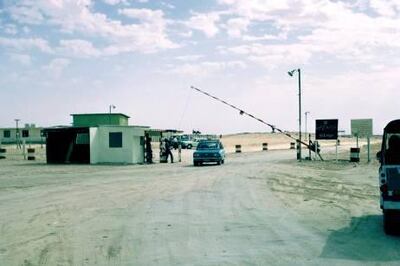
At Seih Ash Sheib, they stopped to show their passports – border controls were still in place – and saw in front of them: “A multitude of tracks across the desert, which being mainly sabqa was largely featureless, with the dunes occasionally close, or a dramatic uneroded sandstone cliff, a geological fossil of an ancient land surface.
Jolting across tracks rutted by constant use, it was early afternoon when the Land Rover pickup, with Jackson sitting in the back, finally reached the Maqtah, where tarmac resumed. “It must have taken us at least a good six hours to cover what takes just over an hour today,” Jackson recalls. “I don’t think my back was ever the same again.”
Jackson's trip was made a little easier by the construction of the first span of the Maqta Bridge, completed in 1967. Four years later, it was clear that the lack of a proper highway between Abu Dhabi and Dubai was proving a serious obstacle to the development of the.
The concept of a paved road between Abu Dhabi and Dubai was already four years old when construction finally began in 1972.
The road was conceived in Abu Dhabi, on January 22, 1968, at a historic meeting between Sheikh Zayed and Sheikh Rashid, in which the Rulers of Abu Dhabi and Dubai agreed to a closer relationship between the two Emirates that would result, in December 1971, with the creation of the UAE.
The joint communique issued that day contained the following key clause: “In order to facilitate the binding together of the two countries, Sheikh Zayed bin Sultan decided to pave the motor road between Dubai and Abu Dhabi.”
Paved roads had already been built between Al Ain and Abu Dhabi, and from Dubai to Ras Al Khaimah when construction began between the UAE’s two biggest cities several months after the country’s birth.
Even after unification, border controls were still enforced until the details of a customs union could be worked out. From Dubai a paved road ran about half way to the border. In Abu Dhabi, the road was paved until the Maqta Fort, built at the end of the 1940s on the mainland side of the Maqta Bridge. Between the two was only sand and meandering tracks.
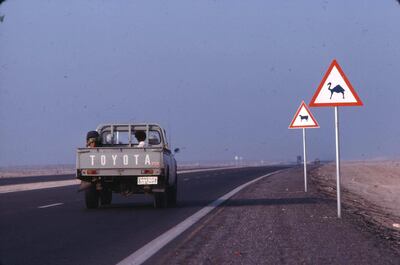
In its initial phase, the new road was a single carriageway in each direction. Each Emirate was responsible for the construction to the edge of its own border. In Abu Dhabi, the road would begin outside the city, at the junction with the existing highway to Al Ain, which was simply known as "the crossroads", or Al Mafraq – the name it is still known as today.
In Dubai, the new road would begin at the Defence Roundabout or First Interchange and push through past Jebel Ali. While the border controls have long gone, the demarcation line can still be seen to this day, with a line in road created by the different colours of the two road surfaces.
By 1973, the road was all but complete, but then it was already clear that a single carriageway was completely inadequate for the volume of traffic.
While the highway was undoubtedly a faster way to reach the two cities, the likelihood of travellers arriving in one piece, or even alive, had been severely reduced.
Dehydration, heat and mechanical breakdown were no-longer the most pressing concerns. In its initial phase new road lacked lighting, fencing and crash barriers.
What it did have was drivers keen to test out how fast the journey could be made, and roaming livestock, including camels, which constantly wandered across the tarmac at all hours. The results were often predictable, for human and animal.
Paul Eide, a Canadian working for the Higher Colleges of Technology, recalls driving to Dubai around 1989, when it was still a single carriageway but about to be widened to two lanes.
“In the good parts it was two lanes and they were paved,” he says. “But not paved well. There were potholes and surprises in the road because of the changing terrain. I would describe some places as not being better than a gravel path.”
Accidents were frequent and danger could arrive without warning. “There was no median [barrier] so cars could come through and we lost our project manager because a car came through the median, which was trees, and hit him head on, on his way from Abu Dhabi
to Dubai.”
With another expansion completed by the mid 1990s, barriers and lighting were added, along with the first rest stops. Before then drivers who ran out of fuel and failed to pack a spare can of petrol faced a long trek back to either Abu Dhabi or Dubai to fetch supplies.
The uneven road surface also took its toll on his Jaguar: “When I first started diving that car it was like a pillow every inch of the way. But the suspension quickly became broken and it was moving up and down like a see-saw.”
What was at stake came home one night when Eide was driving the Canadian ambassador and both their wives home from a function in Dubai.
“It was about two o’clock. The two wives were sleeping in the back and the ambassador was on the passenger side and he was beginning to nod off. I was feeling sleepy myself and all of a sudden I jerked the wheel because there were camels in the road and we were driving at highway speeds.
“When I jerked away, it was to miss a camel and something literally hit the wing mirror and made a loud noise and woke them all up. I realised what kind of responsibility you had when you were driving that road, especially at night.”
On the orders of Sheikh Zayed, construction began on a second carriageway alongside the first, creating a four-lane motorway. Since then, the E11 has been upgraded at least twice to create the multi-lane highway that speeds travellers between the two cities in less than an hour and a half.
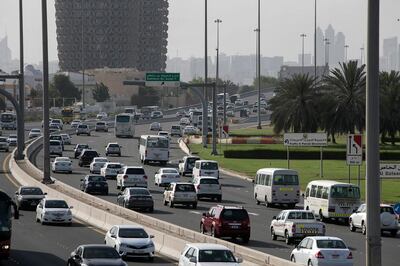
In the 1990s, the Dubai section of the E11 was renamed Sheikh Zayed Road in honour of the President. In reply, Abu Dhabi renamed its section Sheikh Maktoum bin Rashid Road.
Even today the road remains a work in progress, with a major widening project and junction at Al Samha to serve the new Kizad Port and industrial area, improvements to signage, and more rest stops and petrol stations.
Urban growth and tree planting projects means that the desert vistas have all but gone. Camels no longer wander across the highway. The old border is approached past a Bollywood theme park and an American drive-in. So much has changed – except one. This is still the only route between Abu Dhabi and Dubai.
